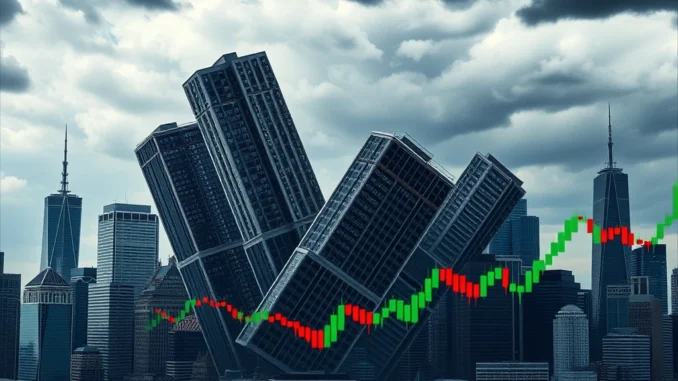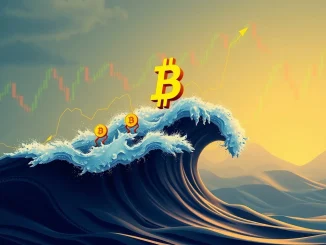
Are you feeling the chill in the crypto air? The market’s recent dip has many investors on edge, wondering what’s behind this sudden downturn. Forget the whispers of trade wars for a moment, because according to the astute minds at The Kobeissi Letter, the real culprit is a dramatic and rapid shift in risk appetite. Let’s dive into what this means and how it impacts your crypto portfolio.
What Exactly Triggered This Market Decline?
In a recent commentary shared on X, The Kobeissi Letter pinpointed the root cause of the market’s woes: a seismic shift in investor sentiment. It wasn’t some drawn-out economic battle, but rather a lightning-fast change of heart among investors. Think of it like this:
- Extreme Greed to Extreme Fear: Within a matter of days, the prevailing mood in the market flipped from ‘get rich quick’ to ‘panic sell’. This whiplash effect is a significant driver of volatility.
- Polarized Positioning: Market positioning had become so heavily skewed towards one direction (presumably bullish) that any shift in sentiment was bound to cause a significant correction. Imagine a rubber band stretched too tight – it’s bound to snap back hard.
- Sharp Reversal: This combination of rapid sentiment change and extreme positioning created the perfect storm for a market reversal. The Kobeissi Letter emphasizes that this reversal was driven by internal market dynamics rather than external factors like trade wars.
So, it wasn’t a slow burn, but a sudden gust of fear that swept through the markets. But what does ‘risk appetite’ really mean in this context?
Understanding Risk Appetite: Are You Feeling Risky?
In simple terms, risk appetite refers to how much risk investors are willing to take on. When risk appetite is high, investors are more comfortable investing in potentially higher-return but also higher-risk assets, like cryptocurrencies. Conversely, when risk appetite is low, investors flock to safer havens, like government bonds or cash. Think of it like this table:
| Market Sentiment | Risk Appetite | Investor Behavior | Asset Class Preference |
|---|---|---|---|
| Extreme Greed | High | Aggressive buying, FOMO | Cryptocurrencies, high-growth stocks |
| Extreme Fear | Low | Panic selling, risk aversion | Cash, government bonds, stable assets |
The Kobeissi Letter highlights that the market experienced a dramatic swing from the ‘Extreme Greed’ column to the ‘Extreme Fear’ column in a very short period. This rapid shift is what triggered the recent market decline.
Investor Sentiment: The Emotional Rollercoaster of the Market
Investor sentiment is essentially the overall mood or feeling of investors towards the market. It’s driven by a mix of emotions – greed, fear, hope, despair – and can be heavily influenced by news, events, and market movements themselves. Here’s why understanding investor sentiment is crucial:
- Predictive Power (Sometimes!): While not a foolproof crystal ball, shifts in investor sentiment can often foreshadow market movements. Extreme greed can signal a market top, while extreme fear can sometimes indicate a bottom.
- Volatility Driver: As we’ve seen with this recent market reversal, rapid changes in sentiment can amplify market volatility. Emotional reactions can lead to overreactions, causing prices to swing wildly.
- Market Psychology: Understanding investor sentiment is key to grasping market psychology. Markets are not purely rational; they are driven by human emotions and biases.
The Kobeissi Letter points out that the speed and intensity of the sentiment shift were key factors in the recent downturn. It wasn’t a gradual cooling off, but a sudden plunge into fear.
The Anatomy of a Market Reversal: How Did Greed Turn to Fear So Fast?
A market reversal, like the one described by The Kobeissi Letter, is a significant change in the direction of a market trend. In this case, it was a reversal from an upward trend (or at least a period of stability) to a downward trend. What factors contribute to such a sharp reversal?
- Leverage and Margin Calls: When markets are riding high, investors often use leverage (borrowed money) to amplify their gains. However, when prices start to fall, margin calls (demands to deposit more funds) can trigger forced selling, exacerbating the decline.
- Stop-Loss Orders: Many traders use stop-loss orders to limit potential losses. When prices hit these stop-loss levels, automatic sell orders are triggered, adding further downward pressure.
- Herd Mentality: Fear can be contagious. When some investors start selling due to fear, others may follow suit, creating a snowball effect. This herd mentality can amplify both upward and downward movements.
- Lack of Liquidity: In times of panic, market liquidity can dry up. This means there are fewer buyers willing to step in, making it harder to sell without driving prices down further.
The Kobeissi Letter’s analysis suggests that these factors, combined with the pre-existing polarized market positioning, created a cascade effect, leading to the sharp market reversal.
Actionable Insights: Navigating Market Volatility
So, what can you, as a crypto investor, learn from this episode and The Kobeissi Letter’s insights? Here are some actionable takeaways:
- Monitor Investor Sentiment: Keep an eye on indicators of investor sentiment. While not always perfect, they can provide clues about potential market shifts. Look for sentiment surveys, fear & greed indices, and social media discussions.
- Manage Your Risk Appetite: Be honest with yourself about your own risk tolerance. Don’t get caught up in market hype and take on more risk than you’re comfortable with.
- Diversify Your Portfolio: Diversification is key to weathering market storms. Don’t put all your eggs in one basket. Spread your investments across different asset classes.
- Stay Informed, But Don’t Panic: Keep yourself informed about market news and analysis, but avoid making impulsive decisions based on fear. The market is cyclical, and downturns are a natural part of the process.
- Consider Dollar-Cost Averaging: Instead of trying to time the market perfectly, consider dollar-cost averaging (DCA). This involves investing a fixed amount of money at regular intervals, regardless of the price.
The Kobeissi Letter: A Voice of Reason in Volatile Markets
The Kobeissi Letter’s commentary serves as a valuable reminder that market movements are often driven by complex factors beyond simple narratives. Their focus on risk appetite and investor sentiment provides a deeper understanding of the recent market decline and the nature of market reversal. By paying attention to these psychological undercurrents, investors can better navigate the ever-changing landscape of the cryptocurrency market.
In conclusion, while trade wars and other macroeconomic factors may play a role in the broader economic picture, The Kobeissi Letter highlights that the immediate trigger for this particular market downturn was a rapid and significant shift in investor psychology. Understanding this shift is crucial for making informed investment decisions and weathering future market volatility. Remember, fear and greed are powerful forces in the market, and recognizing their influence can be your most valuable asset.



